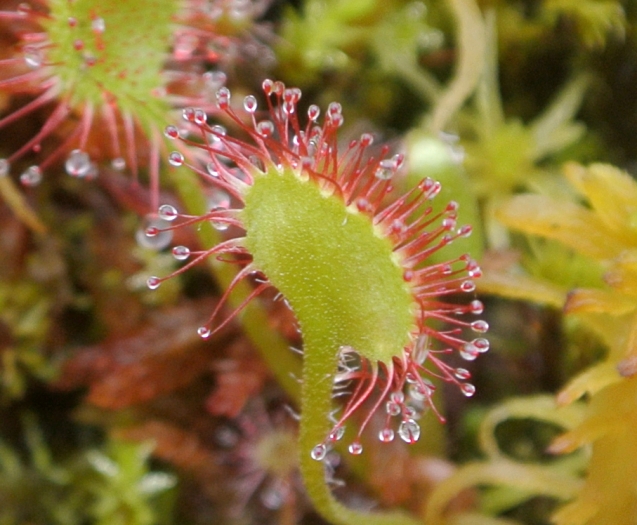Roundleaf Sundew
(Drosera rotundifolia)
Roundleaf Sundew (Drosera rotundifolia)
/
/

Wilson44691
CC0
Image By:
Wilson44691
Recorded By:
Copyright:
CC0
Copyright Notice:
Photo by: Wilson44691 | License Type: CC0 | License URL: http://creativecommons.org/publicdomain/zero/1.0/deed.en | Uploader: Wilson44691 | Publisher: Wikimedia Commons | Title: Drosera_rotundifolia_Brown's_Lake_Bog.jpg | Notes: |





















































Estimated Native Range
Summary
Drosera rotundifolia, commonly known as Roundleaf Sundew, is an evergreen perennial herb that thrives in the acidic, nutrient-poor conditions of bogs, fens, and wetlands across North America, Europe, and Asia. As a carnivorous plant, it supplements its nutrient intake by trapping and digesting insects with sticky mucilage on its spoon-shaped leaves. The Roundleaf Sundew typically forms a compact rosette about 3 to 5 centimeters in diameter. Its inflorescence, which can be 5 to 25 centimeters tall, bears white or pink flowers on one side of a slender stalk. These flowers are modest in size but can be quite showy when in bloom during the summer months. The plant produces tiny, light brown seeds that are slender and tapered. In preparation for winter, D. rotundifolia forms a hibernaculum, a bud of tightly curled leaves at ground level, to survive the cold.
The Roundleaf Sundew is valued for its unique insect-trapping mechanism and is often cultivated by enthusiasts of carnivorous plants. It provides an interesting visual element to terrariums and bog gardens. In cultivation, it requires consistent moisture and prefers full sun, though it can tolerate partial shade. It is important to mimic its natural boggy habitat with acidic, nutrient-poor soil and slow or medium drainage. While it is relatively low-maintenance, care should be taken to avoid fertilizing and to provide a cold dormancy period to ensure the plant’s health. The cultivar ’Charles Darwin’ has been developed to be less dependent on a winter dormancy period. Potential problems include root rot if the soil is too wet and nutrient-rich, and infestations of pests such as aphids.CC BY-SA 4.0
The Roundleaf Sundew is valued for its unique insect-trapping mechanism and is often cultivated by enthusiasts of carnivorous plants. It provides an interesting visual element to terrariums and bog gardens. In cultivation, it requires consistent moisture and prefers full sun, though it can tolerate partial shade. It is important to mimic its natural boggy habitat with acidic, nutrient-poor soil and slow or medium drainage. While it is relatively low-maintenance, care should be taken to avoid fertilizing and to provide a cold dormancy period to ensure the plant’s health. The cultivar ’Charles Darwin’ has been developed to be less dependent on a winter dormancy period. Potential problems include root rot if the soil is too wet and nutrient-rich, and infestations of pests such as aphids.CC BY-SA 4.0
Plant Description
- Plant Type: Herb
- Height: 0.2-0.9 feet
- Width: 0.3-0.5 feet
- Growth Rate: Slow
- Flower Color: White, Pink
- Flowering Season: Summer
- Leaf Retention: Evergreen
Growth Requirements
- Sun: Full Sun, Part Shade
- Water: High
- Drainage: Slow, Medium
Common Uses
Low Maintenance, Potted Plant, Water Garden
Natural Habitat
Bogs, fens, and wetlands across North America, Europe, and Asia
Other Names
Common Names: Round-Leaved Sundew, Common Sundew, Round-Leaf Sundew, Dew-Plant, Rundbladet Soldug, Rundblättriger Sonnentau, Pyöreälehtikihokki, Rossolis À Feuilles Rondes, Droséra À Feuille Ronde, Droséra À Feuilles Rondes
Scientific Names: , Drosera rotundifolia, Drosera rotundifolia var. rotundifolia, Drosera rotundifolia var. comosa, Drosera rotundifolia var. distachya, Drosera corsica, Drosera rotundifolia subsp. breviscapa, Drosera rotundifolia var. corsica, Drosera rotundifolia var. furcata, Drosera rotundifolia var. breviscapa
GBIF Accepted Name: Drosera rotundifolia L.